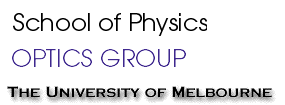2007 Atom optics honours projects
Here are a few more words about some of the possible projects in the atom
optics lab. Expect to have lots of fun, while you learn about quantum
mechanics, lasers, electronics, optics, computer modelling, and
data analysis and visualisation.
Squeezing
Classical measurements with light are limited by Poissonian
uncertainty; that is, to measure, say, 100 photons, inevitably
there is an uncertainty of +/- Sqrt[100], i.e. 10%. Light can
be "squeezed" such that this uncertainty is reduced. Quantum
noise limits can be much lower, but strong squeezing is
notoriously difficult. Recently a new and very simple technique
has been demonstrated using laser interaction with atomic
vapour. In this project, we will demonstrate the method, and
try a new idea which promises squeezing with very low laser
power.
Non-interferometric phase imaging
Electromagnetic waves are traditionally described by an amplitude and
a phase. Imaging typically uses the amplitude (or intensity), but
phase imaging can offer advantages. For example, absorption
(amplitude) imaging of ultra-cold atoms inherently causes heating;
off-resonant phase imaging can be much less destructive.
We have developed new phase-imaging techniques based on diffraction of
a laser beam by a sample of cold atoms. The intensity of the
diffracted probe beam is recorded with a CCD camera, and using our
understanding of diffraction and of light-atom interactions, we can
extract an image of the atomic cloud.
The method allows us to investigate the atomic state, in particular to
image quantum superpositions of states such as used for "slow light"
and "electromagnetically induced transparency". In this project we
will investigate phase shifts in slow-light configurations.
Ultracold plasma
Plasma is normally hot, because separation of electrons from atoms
requires lots of energy. It is possible (in fact, quite easy) to
photo-ionise atoms with a laser tuned to just the right energy to
remove the electron. If the atom is initially very cold, then the
ion+electron will remain cold. Thus by photo-ionising a cloud of cold
atoms - atoms at a temperature of a few hundred micro-Kelvin - we can
produce an ultra-cold plasma.
Such plasmas are an exciting new
playground for all kinds of interesting physics, and also directly
applicable as the source of ultrabright electrons. We are working
towards creating an ultrabright electron source, which will later
become the basis of a new compact x-ray source.
Rydberg atoms
FAT atoms: Making
really big "Rydberg" atoms, in a highly excited but not quite ionised
state, such that the outer electron orbital is as big as a micron in
diameter.
Ghost imaging
Action at a distance, using correlated and entangled photons to image
an object that isn't there.
Atomic clocks
New schemes of locking lasers to coherent quantum states in atoms,
with precision measured in seconds per hundred-thousand-years.


